Blenko 6741 Decanter airtwist Stopper 23 14 Blown Art Glass Joel Myers
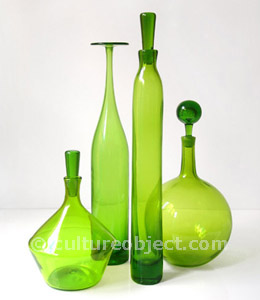
Above: Joel Philip Myers, 4 pieces in Olive Green.
From left to Right, Decanter (#6413), designed in 1964. 12.v"h;
Bottle (#6937), designed in 1969. 22.75"h;
Decanter (#6426), designed in 1964. 24.75"h;
Decanter (#6533), designed in 1965. 17"h.
Article & photos past Damon Crain
Modernism Mag
Volume 10, No. iii, Fall, 2007
Blenko is an ideal example of the dizzying innovation of mid-20th century America and the purest expression of a uniquely American modernist drinking glass art. The best of Blenko's piece of work demonstrates a direct connexion to the revolutionary principles of the fourth dimension in both art and design, be it testify of a Henry Moore and Russel Wright-like sensibility in the work of Blenko's commencement designer Winslow Anderson; the influence of Paul Klee or Le Corbusier in the work of Blenko's second designer, Wayne Husted; or the kinship of Blenko's third designer, Joel Myers, with Richard Diebenkorn'due south sense of colour and Eero Saarinen's mod organic forms. Undoubtedly, this accounts for Blenko'due south entreatment to collectors of all things modern.
The significance of Blenko's contributions to American design and studio drinking glass, especially its core innovations of dramatically enlarged calibration and bold solid colors, has remained largely unrecognized by museums, academics and texts. While experts have cited 1960s Pop Art as the forerunner for the enlarged scale that is seen equally an innovation brought to glass by of the Studio Drinking glass move, Blenko had been developing oversize pieces since at least 1954. In addition, Blenko pioneered a market for affordable modernistic art glass by putting pieces of exceptional design and quality inside economic reach of the largest segment of the population - the bourgeoning middle form - helping to pave the way for the many independent glass studios that followed. The story of Blenko's ascension is the 1 of a company adamant to reinvent itself in guild to succeed during hard times and savvy enough to ride the wave of America 'due south mail service-war years.
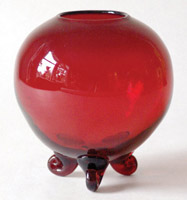 |
| Above: Early Blenko vase in Ruby, c. 1930's. v.25"h x 5"d. |
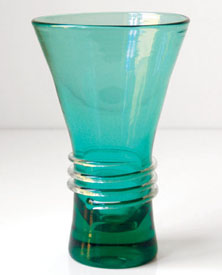 |
| In a higher place: This Blenko Heavy Swedish Type vase #R497) in Ocean Green with Crystal coil, is attributed to Carl Erickson. Designed c. 1940, information technology was shown in the Metropolitan Museum of Art's 1950 Exhibition "Twentieth Century Glass: American and European." 10"h. ten 6.25d. |
Only 2 years later, however, the economic crunch that sparked the Cracking Depression destroyed the market for stained glass, as construction of new buildings came grinding to a halt. Undaunted, Bill Blenko managed to persuade his reticent begetter to diversify and endeavor producing tableware using the same fabric they had been using for sail glass. Pecker approached Carbone & Sons, a Boston retailer and importer of fine Italian and Swedish glassware, with an offering to supply them with a competitive domestically fabricated product. This was a brash proposition; Blenko had never before fabricated tableware.
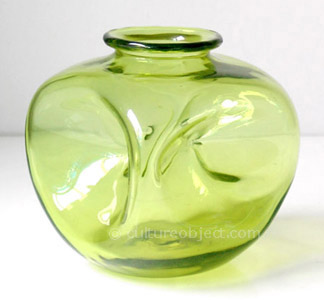
Above: Winslow Anderson, big four-dent vase #910-iv
in Chartreuse, designed 1948, seven.5" h x 5.5"dia
| |
| Above: John Nickerson, Vase (#7220S) in Turquoise, designed in 1972. 12.5"h x 4"d. This vase presages Nickerson'south contained Studio Glass work for which he has since acheived much fame. The vase began as a bottle form, and was and then cut on a bias. Such cold piece of work was uncommon for Blenko, beacuse of the added expense of production |
The brothers Louis Miller and Axel Muller, who had been trained at the Kosta factory in Sweden where their father was a principal glassblower, were swiftly hired past Blenko from the nearby Huntington Tumbler Co. The two about enduringly important regions of glass product in the 20th century were Italy and Scandinavia, both noted for their groundbreaking blueprint sensibility and incomparably skilled craftsmanship; in America, they converged at Blenko.
| |
| To a higher place: Wayne Husted, Vase (#5942L) in Persian, designed in 1959. fifteen.5"h ten 3.75"d. Signed. Shown in the exhibition "Glass 1959" at the Corning Museum of Drinking glass |
A new Scandinavian influence came to Blenko in 1937, in the form of a new Swedish foreman, Carl Erickson, whose father and grandfather were master glassblowers at the Reijmyre manufactory in Sweden . After calculation some noteworthy designs to Blenko's line, marketed as "Swedish Type," Erickson left in 1942 to start his own visitor, the highly regarded Erickson Glassworks. His departure highlighted Blenko's need for design direction, simply the war years would put a agree on whatsoever new developments.
| |
| To a higher place: Wayne Husted "Architectural Scale" three-role Epergne (#5832) in Charcoal, designed in 1958. 35"h ten eleven"d. Signed. The traditional epergne is a dining tabular array centerpiece for presenting fruit, desserts or flowers. Husted'southward version, made of iii individual pieces og glass nestled inside 1 another, exemplifies how he transformed well established objects into entirely new and sculptural forms. |
An artist and designer, Anderson was deeply influenced by the abstract painter Hans Hoffman, and the fine art theory he consort in his volume "Search for the Existent," as well every bit by Bauhaus philosophy and Scandinavian pattern. Anderson as well had the distinct advantage of being steeped in the New York art scene while stationed in Queens during the war. His mixed media artwork was even exhibited at the Metropolitan Museum of Art and the Guggenheim (then the Museum of Non-Objective Art ) in 1944 alongside that of distinguished artists such equally Harry Bertoia and Laszlo Moholy-Nagy.
 |
| Above: Joel Philip Myers, Decanter (#6732L) in Plum, designed in 1967. 29.5"h x 4.25"d. |
Anderson'due south near profound contribution was to gently challenge the rational expectation that designs exist primarily functional. He created forms so refined and refreshing that their function seemed to be no more a fringe do good to the object's sculptural qualities. In 1952, after ambitious attempts to lure him by both Steuben Drinking glass and Raymond Loewy, Anderson left for Lenox China . His departure was a significant blow to Blenko; there was no doubt that the company's strong growth and success were largely due to his intuitive knowledge of glass and his exceptional designs.
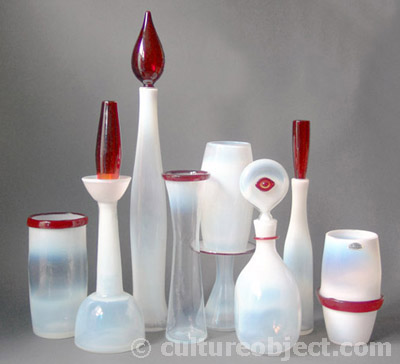
The "Rialto" Specialty Line was 1 of three very adventurous lines Wayne Husted designed in 1960. These lines, both technically and aesthetically different from the company'due south standard line, indicate an impulse to innovate and experiment in spite of the risks. The Specialty Lines are a testament to a visitor in its prime. Rialto 's translucent white was achieved past adding tin to the batch, which had the unfortunate side effect of making the drinking glass much more breakable. Combined with the annealing differential with the applied Red elements the loss rate was very high during manufacture and later on. Very few were fabricated as hardly any were ordered - a as outcome the Specialty Lines were a financial disaster for Blenko, almost forcing them into closure.
Left to right: #15-TO vase, 9.5in.H, #ii-TO decanter, 18.5in.H, #1-TO decanter, 25.75in. #xiii-TO vase, 13.125in.H, #sixteen-TO hurricane viii.5in.H on elevation of #8-TO candleholder, 6.75in.H, #4-TO decanter, xiv.25in.H, #3-TO decanter, 17in.Hm #12-TO vase, 8.5in.H
| |
| Above: John Nickerson "Charisma" Specialty Line Vase (#7221X) in Crystal with Ruddy, designed in 1972. 17.25"h x 3.75"d. "Charisma" was the beginning Specialty Line Blenko had attempted since 1961. With its Ruby garland color suspended in Crystal, the line refined a 19th-century American glass production technique from the mid-Atlantic region. |
Not coincidentally, Anderson 's tenure also marked the beginning of the inclusion of Blenko pieces into a new blazon of museum bear witness and so proliferating effectually the land. These influential and pop juried exhibitions promoting modernistic design were organized by museums convinced of the need for arbiters of good taste for the masses at a time of unparalleled cultural evolution. Retailing and so in the range of $iii-$25 (most $25-130 in today'south dollars) Blenko glass was luxury good for the middle-form and a prime number candidate for these exhibitions. Blenko'southward products were included in the "etroit Institute of the Arts "An Exhibition for Modern Living" in 1949 and the Museum of Modern Art 'south popular semi-almanac "Good Design" shows from 1950 through 1954. Blenko's critical success is easy to explain: quite merely, no other American glass company was producing new, modern shapes in hand-blown drinking glass at this fourth dimension. Blenko had the market place cornered.
In 1953, Wayne Husted, Blenko's bold new designer, as well fresh from Alfred Academy , arrived with a single-minded fervor and vision. The door that Anderson had nudged open, Husted blew abroad entirely. For Husted, vessels were no more a pretense for creating abstract, sculptural shapes. A 1958 New York Times article entitled "Glass Objects Reverberate Trend to Art in Home Today" demonstrated the sculptural qualities of Husted's work by featuring his Blenko designs aslope Venini glass by Fulvio Bianconi.
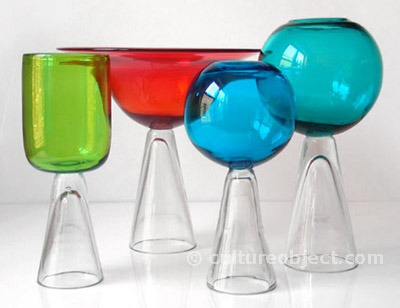
Above: Joel Philip Myers, cone-footed vases, designed in 1970. From left to right: #7041 in Olive Green. 12.5"h; #7042 in Tangerine. 12.75"h; #7043S in Turquoise. 14"h; #7043L in Surf Green. fourteen.25"h.
| |
| Higher up: Hockaday Associates, blenko ad, 1961, incorporating Wayne Husted designs |
Blenko's third designer, Joel Philip Myers, arrived in 1963. Myers's artful was already quite sophisticated; he had worked with Donald Deskey in New York and Richard Kjaergaard, an influential ceramist, in Denmark . Myers was enlightened of the nascent Studio Drinking glass movement and quickly set near learning glass blowing himself. Effectively maintaining an independent practice every bit a glass artist while at Blenko, Myers became an early and active participant in the Studio Glass move. By his ain account, allowed Myers to meet the possibility of his own career as a studio glass artist while designing for the mill. "Blenko has permitted me complete creative freedom and has encouraged me to experiment," he said. "My experimental work contributes many ideas and directions for use in our regular line.There is no reason to think that working for industry compromises a craftsman's aesthetic values."
| |
| Above: Blenko ad designed by Joel Philip Myers, 1967showing Myers designs from that year |
At Blenko, Myers conspicuously reveled in the 1960s psychedelic re-interpretation of the Art Nouveau aesthetic, with masterfully exaggerated organic vessel forms. "I permit the glass to sag, flop, flow, stop, starting time, stretch," he said. "I command and still am beingness dictated to by the glass.." Myers introduced some of Blenko'due south best gaffers to the possibility of artistic creation and, as a effect, a few, including Shorty Finley and Earl Carpenter, developed noteworthy renown in their ain right. This firsthand connection between Blenko and the Studio Drinking glass movement but deepened during Myers' fruitful tenure.
Myers's later, very influential studio work belies an undeniable interest in color that was surely nurtured by his involvement with Blenko. In evaluating his contemporary work, critics regularly cite colour as a primary business, simply accredit this narrowly to an interest in artists such as Henri Matisse and Marking Rothko, as if unaware of his eight-year tenure at a glasshouse whose founding concern was color.
Myers began exhibiting his ain glass while at Blenko, including at the Toledo Glass National Ii in 1968 aslope glass masters Fritz Dreisbach, Dominick Labino, Marvin Lipofsky and Richard Marquis and at the Smithsonian Establishment's "Ceramic Arts USA" in 1966, an invitational exhibition featuring leading American artists, where he showed with Labino. Myers introduced Lipofsky to Blenko in 1968 and Dreisbach in 1976. (A sculpture that Lipofsky made at Blenko in 1968 is now in the collection of the Smithsonian'south Cooper-Hewitt National Design Museum.) Myers's inclusion in the seminal 1969 exhibition "Objects U.s.a." is attestation to the importance of Blenko not simply to the Studio Drinking glass motility simply to the larger Craft Motility as well. Myers left Blenko to establish the glass department at Illinois State University and today ranks as one of the nigh recognized and exhibited glass artists in the world.
| |
| Blenko Itemize cover |
Blenko appeared again at the Metropolitan Museum in the exhibition "Craftsmanship in America" in 1952, only mayhap the near significant exhibition to include Blenko at this time was the groundbreaking "Glass 1959," a juried international earth-wide survey of the glass industry at the Corning Museum of Glass. Blenko's entry was an exceptional design: a cylindrical vase with u-cut pinnacle and weighted encased crystal base of operations, designed expressly for the evidence by Wayne Husted. Its presence aslope the likes of internationally esteemed houses Salviati, Venini, Kosta and Orrefors lent Blenko important exposure and prestige. More recently, the Corning Museum included Blenko in a small simply powerful survey exhibition entitled "Decades in Drinking glass: the '50s."
| |
| Above: Wayne Husted "Accents,: designed in 1958, both in Tangerine. #5730L, 10"h, left, and #5730, 7.75"h, right. |
Unbeknownst to Blenko, its fourth designer, John Nickerson, hired in 1971 and the commencement to make it well versed in studio glass, heralded the bear on of the emerging Studio Glass movement. Ironically, Nickerson's designs generally shunned the more flamboyant Studio Glass influence in favor of a simpler, more restrained artful, with a renewed focus on the functional vessel grade. No doubt this was in part due to the new president, William H. Blenko Jr., grandson of the founder who called for new priorities for a new time. He imposed a more commercial standard, with more conservative colors and simpler designs that could be executed efficiently with less handcraft skill. At the same time, work past Studio Glass artists and small companies inspired by or founded past Studio Drinking glass artists, was becoming more mature and accessible. After only four years' tenure, Nickerson left Blenko to cultivate his own successful independent Studio Glass practice, participating in numerous exhibitions including the Corning Museum 's "New Drinking glass '79."
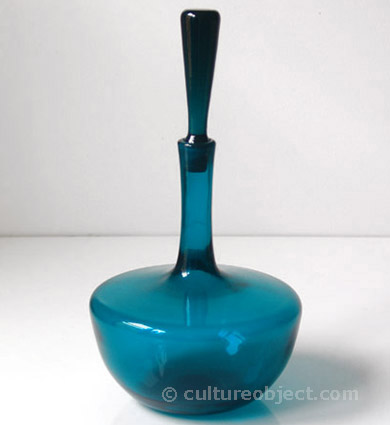
Blenko'south success stemmed from its progressive attitude, its fearless young designers and, of form, high quality, handmade glass never before seen in such large-scale, fantastical shapes or bold colors, of an importance not seen since Tiffany'due south domination of American Art Nouveau glass. In a twoscore year period of fostering dramatic new aesthetic developments and pioneering pattern, Blenko built a market for and a national sensation of modern art glass: sculptures for the domestic environment.
In a higher place: all Joel Philip Myers designs
Source: https://www.cultureobject.com/press-2007-modernism.htm
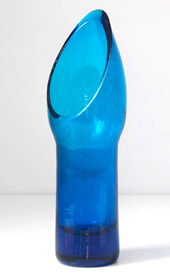
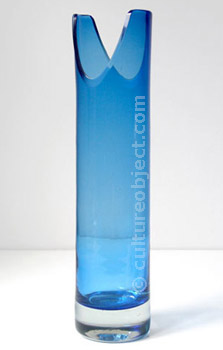
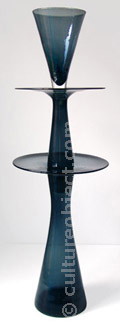
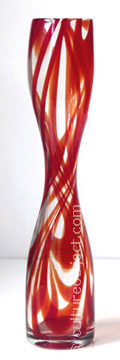
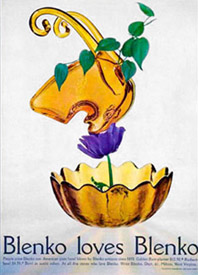
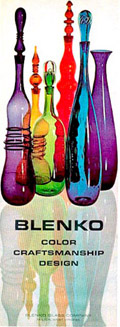
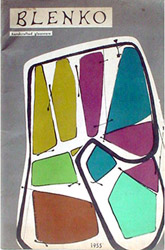
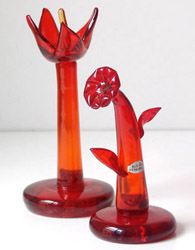
0 Response to "Blenko 6741 Decanter airtwist Stopper 23 14 Blown Art Glass Joel Myers"
Post a Comment